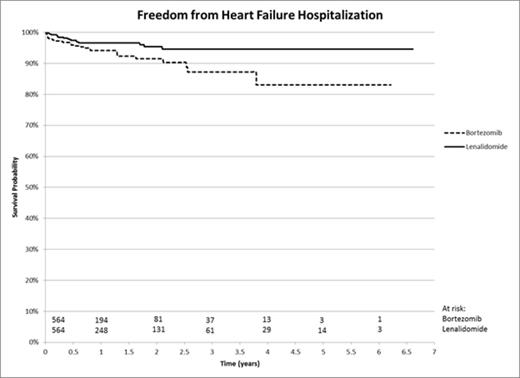Abstract
Background: Proteasome inhibitors and immunomodulatory drugs are currently an integral part of the management of multiple myeloma. Pre-clinical and clinical studies suggest that bortezomib, the first approved proteasome inhibitor for the management of multiple myeloma, may be associated with an increased risk of cardiac events such as heart failure (HF), acute myocardial infarction (MI), and arrhythmia. The goal of this study was to evaluate the rate of adverse cardiac events in patients treated with bortezomib compared to lenalidomide.
Methods: This retrospective, propensity-matched study using a large, national administrative claims database included multiple myeloma patients who initiated bortezomib and a comparison group (matched on age, sex, year of drug initiation, baseline HF, hyperlipidemia, hypertension, history of MI, arrhythmia and Charlson comorbidity index) who initiated lenalidomide between January 2008 and December 2014. Those who received both bortezomib and lenalidomide were excluded from the analysis. The primary endpoints were time to hospitalization for HF, acute MI and arrhythmia. Rates of hospitalizations were computed per 100 patient years (PY). Cox proportional hazard models were used to obtain hazard ratios (HR) and 95% confidence intervals (CI).
Results: A total of 1,128 patients (564 bortezomib users and 564 lenalidomide users, mean age of 69, 47% female, and average follow-up time of 438 days) were included in the analysis. The rate of hospitalization for HF, acute MI, and arrhythmia was 5.76/100 PY, 2.57/100 PY, and 3.10/100 PY respectively among bortezomib users and 2.45/100 PY, 1.47/100 PY, and 2.85/100 PY respectively among lenalidomide users. In the propensity score matched models, the risk of hospitalization for acute MI and arrhythmia with bortezomib was similar to lenalidomide (HR 1.60 [95% CI 0.73-3.49] and HR 1.01 [95% CI 0.54-1.90] respectively).
The risk of hospitalization for HF with bortezomib use was significantly higher compared to lenalidomide (HR 2.10 [95% CI 1.18-3.74], Figure 1). Further stratification of the patient population by baseline HF status showed that those with baseline HF (n=212) were significantly more likely to be hospitalized for HF following treatment with bortezomib compared to lenalidomide. The rate of hospitalization for HF in the population with baseline HF was 24.12/100 PY among bortezomib users and 8.77/100 PY among lenalidomide users (HR 2.24 [95% CI 1.04-4.83]). Those without baseline HF (n=916) had similar rates of hospitalization for HF when treated with bortezomib and lenalidomide (2.83/100 PY and 1.29/100 PY respectively, HR 2.05 [95% CI 0.86-4.91]).
Conclusion: The current study shows that bortezomib use in patients treated for multiple myeloma is associated with an increased risk of hospitalization for heart failure, but not acute MI or arrhythmia. Those with HF prior to initiating therapy with bortezomib had a significantly increased risk of hospitalization for HF when compared to those treated with lenalidomide. There was no significant difference in the rate of hospitalization for HF in those without a baseline diagnosis of HF. Collectively, these data have important implications for the management of patients with multiple myeloma, especially those with a history of HF at the time of therapy initiation.
Kaplan Meier plot for HF hospitalizations.
No relevant conflicts of interest to declare.
Author notes
Asterisk with author names denotes non-ASH members.


This feature is available to Subscribers Only
Sign In or Create an Account Close Modal